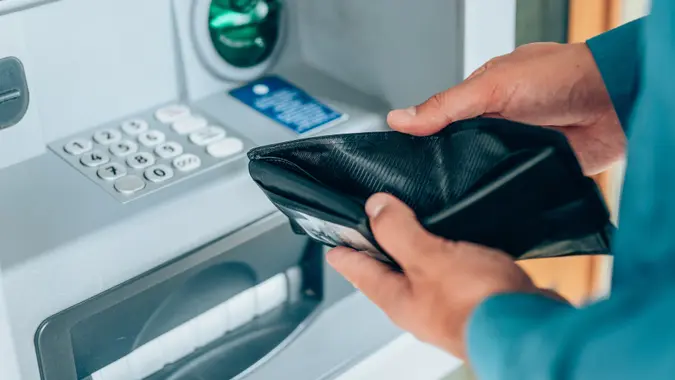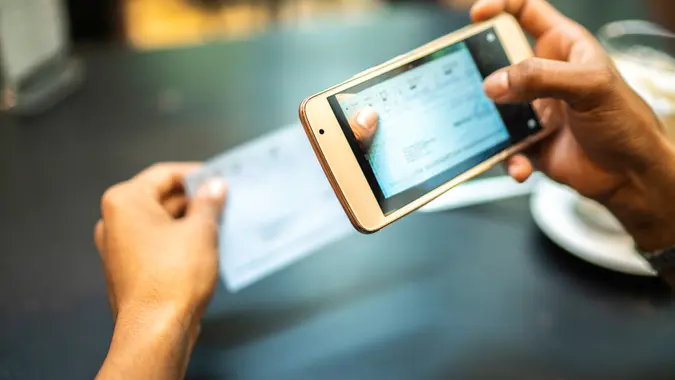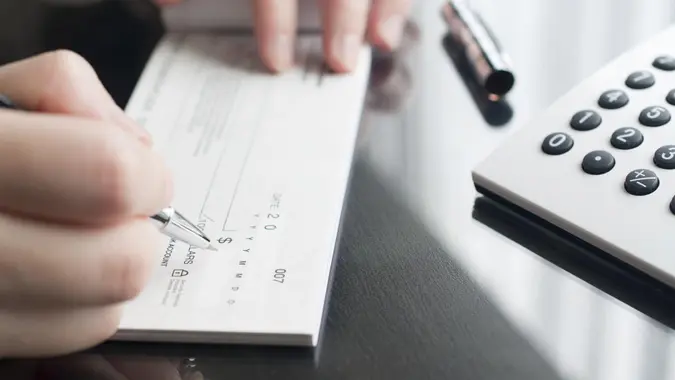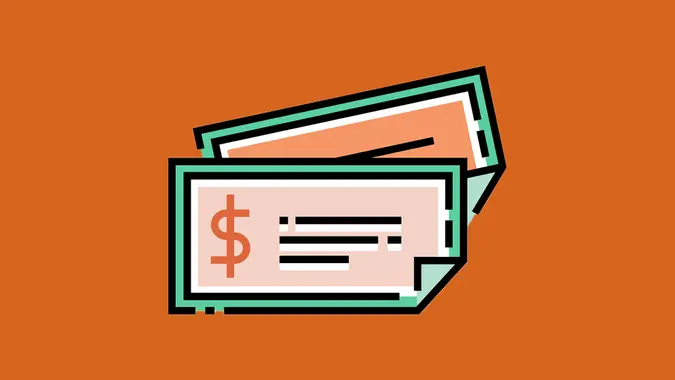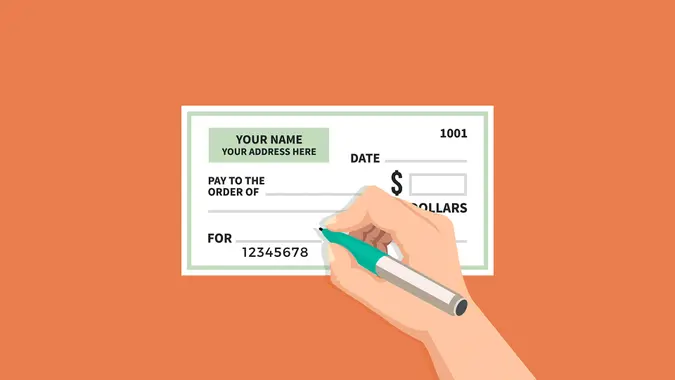Can You Deposit Cash at an ATM?

Commitment to Our Readers
GOBankingRates' editorial team is committed to bringing you unbiased reviews and information. We use data-driven methodologies to evaluate financial products and services - our reviews and ratings are not influenced by advertisers. You can read more about our editorial guidelines and our products and services review methodology.

20 Years
Helping You Live Richer

Reviewed
by Experts

Trusted by
Millions of Readers
Your bank is closed, but you need to deposit cash into a bank account. If you find yourself in this situation, you may still have options. Many ATMs accept cash deposits.
Find out how to deposit cash at ATM through a step-by-step guide and safety tips.
Where Can You Deposit Cash?
You can deposit cash at a bank, a store or many ATMs. Not all ATMs accept cash deposits, though, so you’ll need to find one that works with your bank.
For example, small ATMs in convenience stores typically don’t accept cash deposits, nor do some small banks and credit unions.
Contact your financial institution to find out whether you can make ATM cash deposits, and if so, where.
How To Deposit Cash at an ATM
To deposit cash at an ATM, follow the following steps:
- Locate an ATM. Many bank websites have a locator tool to find a bank branch near you, and some even have filters to help you find an ATM that accepts cash deposits.
- Insert your debit card and enter your PIN.
- Select the “Deposit” option from the ATM menu
- Choose “Cash” as the deposit type
- Insert your cash into the ATM. There might be a limit to how much cash you can deposit at once and the orientation the ATM accepts.
- Confirm the correct amount was deposited.
- Get the receipt and keep it for your records.
- Sometimes, the ATM might reject wrinkly bills. Smooth them out and try again.
- If the ATM doesn’t show the proper deposit amount or confirm your deposit, contact the bank.
How Much Cash Can You Deposit at an ATM?
How much cash you can deposit at an ATM depends on your bank’s deposit policy. Some banks limit the amount you can deposit each day. Others have an ATM withdrawal limit on the number of bills you can deposit per transaction.
For example, USAA accepts up to 30 bills per ATM deposit. If you need to deposit more than 30 bills, you may need to do so in separate transactions.
Some banks may have a delay in making the deposit you made available. For example, if you deposit $1,000 in cash, only $200 of that might be immediately available. This is because higher dollar amounts may need additional verification.
Plan your deposits a few days before you need them in your account, particularly if you need money in your account for bill payments. This can help avoid overdraft fees, which is a bank charge that occurs when your bank account is overdrawn and results in a negative balance.
Bank-Branded ATMs
To avoid ATM fees on cash deposits, choose a bank-branded ATM.
For example, U.S. Bank and Chase accept cash and check deposits from customers at most of their branded ATMs.
Third-Party ATMs
Several of the best online banks have checking accounts that offer ATM fee reimbursements. You can avoid fees at third-party ATMs with these checking accounts.
Online banks may ask you to visit a physical location to make a cash deposit. For example:
- Discover®, Member FDIC, accepts cash deposits at Walmart stores by using your contactless debit card.
- Axos accepts cash deposits through Green Dot retailers through its partnership.
Is It Safe to Deposit Cash at an ATM?
It is generally safe to deposit your cash at an ATM. However, you should still follow some safety tips:
- Have your card and documents ready: Carry your ATM card and an envelope with your cash when you walk up to the machine. Don’t dig around in your bag or pockets after you get up to the machine.
- Look for skimming devices: Thieves can attach skimming devices to the slot that takes your debit card. Look for any damage, extra pieces or glue that could indicate the machine has been tampered with. If your card doesn’t fit well into the insert slot, that could also be another indication that there’s a skimming device.
- Be aware of your surroundings: Keep your ATM pin private by using your body to block the pin pad. Many ATMs have mirrors that allow you to see if someone is standing behind you.
- Take receipts and leave quickly: Don’t leave any records of your transaction behind. If you’re taking cash out of the ATM, take your money and go. Don’t linger to count your money — do that in your car.
If you experience theft or fraud after a deposit, report it to your bank immediately.
Alternatives to Depositing Cash at an ATM
There are other ways you can deposit your cash. Each option comes with its own advantages and disadvantages.
| Cash Deposit Method | Pros | Cons |
|---|---|---|
| Visiting a bank branch | This method provides extra security when depositing large cash amounts since a bank teller processes the deposit. | Branch hours vary, and many have limited hours on weekends. |
| Depositing money into a prepaid debit card | This method may be acceptable when you need to make a payment but can’t use cash. | Prepaid debit cards may have fees. |
| Getting a cashier’s check, then depositing it into your bank account | This method may be worth considering when more convenient options aren’t possible, like ATMs or branches. | This method may be tedious since it involves several steps. |
Making Successful ATM Cash Deposits
Depositing cash at an ATM can be a convenient way to put money into your bank account. Each financial institution is different, so check your bank’s website, app or customer support to get more details about ATMs that accept cash deposits.
Also, be alert when you make ATM transactions to stay safe and avoid scammers.
Allison Hache, Virginia Anderson, Joshua Rodriguez and Sarah Sharkey contributed to the reporting for this article.
Our in-house research team and on-site financial experts work together to create content that’s accurate, impartial, and up to date. We fact-check every single statistic, quote and fact using trusted primary resources to make sure the information we provide is correct. You can learn more about GOBankingRates’ processes and standards in our editorial policy.
 Written by
Written by  Edited by
Edited by 









